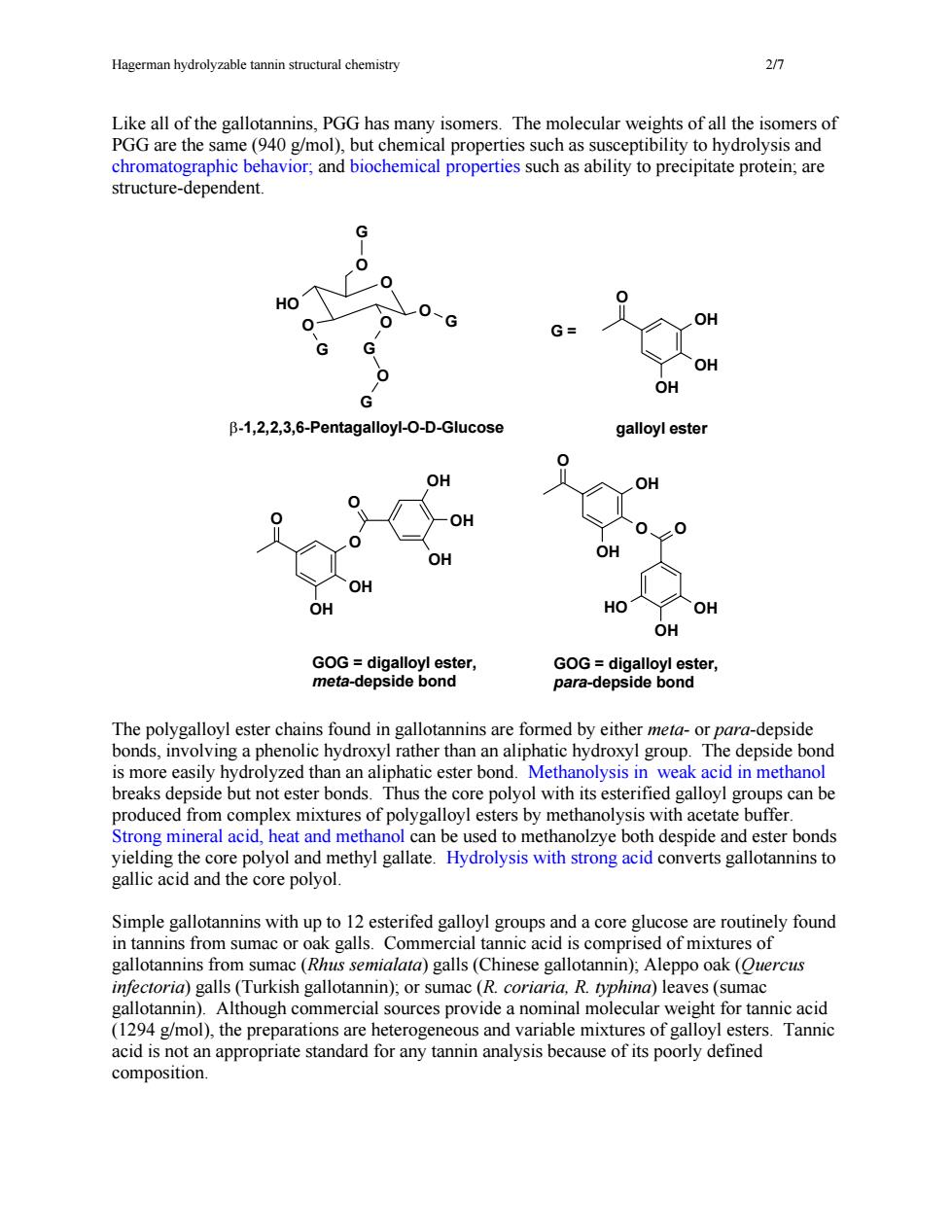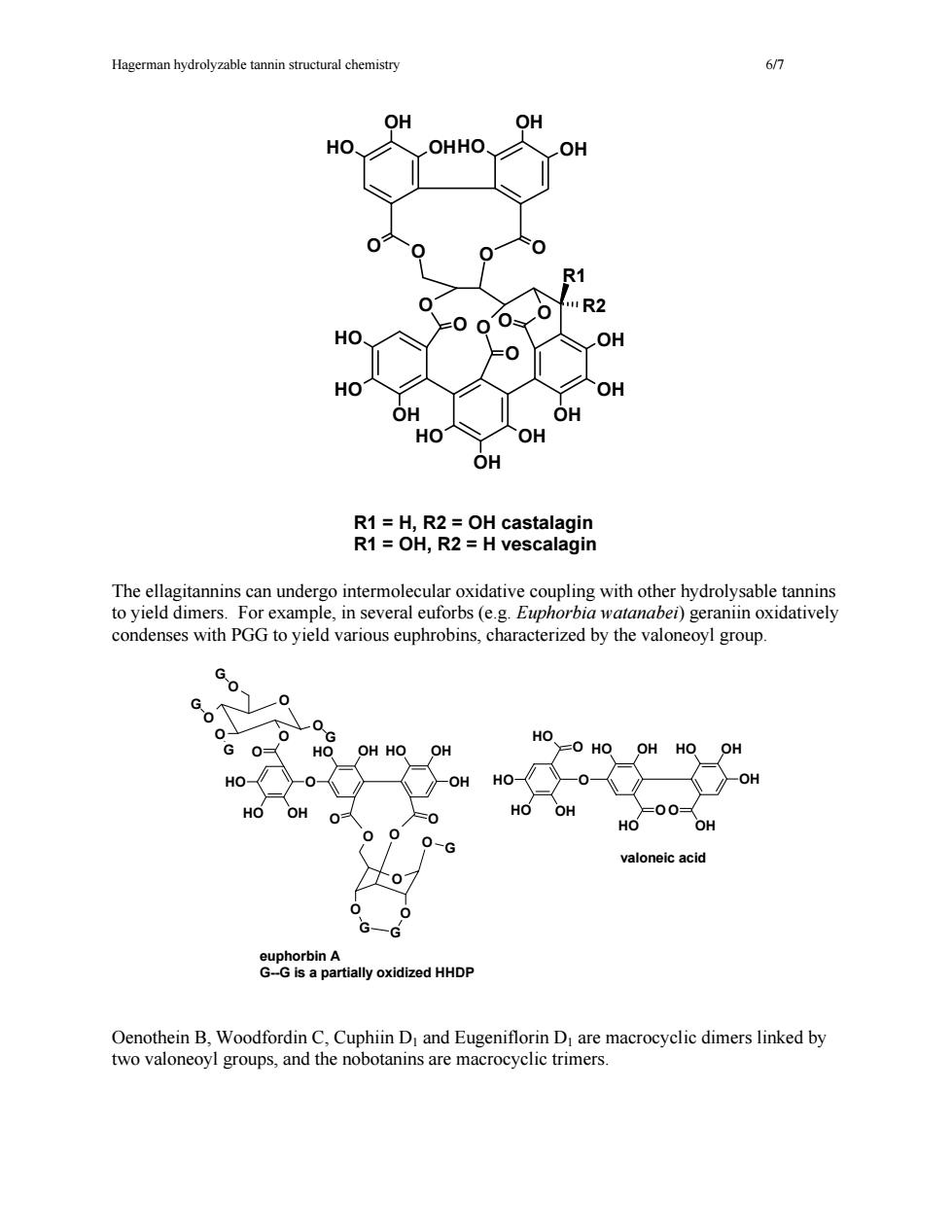
Hagerman hydrolyzable tannin structural chemistry 0 Like all of the gallotannins,PGG has many isomers.The molecular weights of all the isomers of PGG are the same(940 g/mol),but chemical properties such as susceptibility to hydrolysis and chromatographic behavior;and biochemical properties such as ability to precipitate protein;are structure-dependent. G G- OH OH OH B-1,2,2,3,6-PentagalloyI-O-D-GIucose galloyl ester OH OH OH OH GOG=diaallo ester GOG=digalloyl ester meta-depside bond para-depside bond nnins are side bonds,involv ng a phenol hydroxyl rather than an aliphatic hydroxyl group. s more easi hydrolyzed than an aliphatic ester bond Methanolysis in weak acid in methano breaks depside but not ester bonds.Thus the core polyol with its esterified galloyl groups can be produced from complex mixtures of polygalloyl esters by methanolysis with acetate buffer. Strong mineral acid,heat and methanol can be used to methanolzye both despide and ester bonds yielding the core polyol and methyl gallate.Hydrolysis with strong acid converts gallotannins to gallic acid and the core polyol. Simple gallotannins with up to 12 esterifed galloyl groups and a core glucose are routinely found in tannins from sumac or oak galls.Commercial tannic acid is comprised of mixtures of gallotannins from sumac (Rhus semialata)galls (Chinese gallotannin).Aleppo oak(Ouercus infectoria)galls(Turkish gallotannin)or sumac (R.coriaria.R.typhina)le es (sumac in).Although commercial so ide a ominal m eight for tannic acid 1294 /mol).the are het and, Tan acid is at appropr dard for any is he ofits poory omposition
Hagerman hydrolyzable tannin structural chemistry 2/7 Like all of the gallotannins, PGG has many isomers. The molecular weights of all the isomers of PGG are the same (940 g/mol), but chemical properties such as susceptibility to hydrolysis and chromatographic behavior; and biochemical properties such as ability to precipitate protein; are structure-dependent. The polygalloyl ester chains found in gallotannins are formed by either meta- or para-depside bonds, involving a phenolic hydroxyl rather than an aliphatic hydroxyl group. The depside bond is more easily hydrolyzed than an aliphatic ester bond. Methanolysis in weak acid in methanol breaks depside but not ester bonds. Thus the core polyol with its esterified galloyl groups can be produced from complex mixtures of polygalloyl esters by methanolysis with acetate buffer. Strong mineral acid, heat and methanol can be used to methanolzye both despide and ester bonds yielding the core polyol and methyl gallate. Hydrolysis with strong acid converts gallotannins to gallic acid and the core polyol. Simple gallotannins with up to 12 esterifed galloyl groups and a core glucose are routinely found in tannins from sumac or oak galls. Commercial tannic acid is comprised of mixtures of gallotannins from sumac (Rhus semialata) galls (Chinese gallotannin); Aleppo oak (Quercus infectoria) galls (Turkish gallotannin); or sumac (R. coriaria, R. typhina) leaves (sumac gallotannin). Although commercial sources provide a nominal molecular weight for tannic acid (1294 g/mol), the preparations are heterogeneous and variable mixtures of galloyl esters. Tannic acid is not an appropriate standard for any tannin analysis because of its poorly defined composition. OH OH OH O G = galloyl ester O HO OH OH O OH OH O O OH OH OH O OH OH O G O HO O O O O G G G G O β-1,2,2,3,6-Pentagalloyl-O-D-Glucose GOG = digalloyl ester, para-depside bond GOG = digalloyl ester, meta-depside bond

Hagerman hydrolyzable tannin structural chemistry PGG can be prepared from some commercial tannic acids by methanolysis in acetate buffer.For the preparation to be successful,the tannic acid must have PGG as its core ester,most likely in 3omoiCgcorTaeegtenennsompmicdorecacsot G H.C.o OH G. +0 G.O-G OH % methyl gallate PGG 0 。 06 on H,C -OH HO、 H90 -0 OH glucose Although for many gallotannins glucose is the alcohol,other polyols including glucitol; hammamelose:shikimic acid;quinic acid;and quercitol;have been reported as constitutents of gallotannins from a few species.For example,aceritannin is found in leaves of several species OH OH OH OH OH HO OH HO HO OH HO OH OH OHOH aceritannin 2,6-di-O-galloyl-1,5-anhydro-D-glucitol hamamellitannin of maple(Acer),and hamamelitannin is found in bark of witch hazel (Hamamelis virginiana) ak (Quercus and se ral che spe s(Castanea sp.)
Hagerman hydrolyzable tannin structural chemistry 3/7 PGG can be prepared from some commercial tannic acids by methanolysis in acetate buffer. For the preparation to be successful, the tannic acid must have PGG as its core ester, most likely in preparations of Chinese or sumac gallotannin. Turkish gallotannin is comprised of esters of 1,2,3,6-tetragalloyl glucose; or 1,3,4,6-tetragalloyl glucose. Although for many gallotannins glucose is the alcohol, other polyols including glucitol; hammamelose; shikimic acid; quinic acid; and quercitol; have been reported as constitutents of gallotannins from a few species. For example, aceritannin is found in leaves of several species of maple (Acer), and hamamelitannin is found in bark of witch hazel (Hamamelis virginiana), oak (Quercus rubra), and several chestnut species (Castanea sp.). O OH OH OH O HO O O OH OH OH O HO H H O OH HO HO O O OH OH OH O O OH OH OH aceritannin 2,6-di-O-galloyl-1,5-anhydro-D-glucitol hamamellitannin O OH OH OH O H3C G G G G O O O O O O G G G G G O O O O O OH OH OH O H3C O O O O O O G G G G G O HO OH HO HO OH nonagalloyl glucose methyl gallate PGG + methyl gallate glucose + Methanol Acetate buffer Methanol Sulfuric acid

Hagerman hydrolyzable tannin structural chemistry Ellagitannins. Oxidative coupling of galloyl groups converts gallotannins to the related ellagitannins.The simple ellagitannins are esters of hexahydroxydiphenic acid(HHDP).HHDP spontaneously lactonizes to ellagic acid in aqueous solution. OH gallotannin OH HO OH HO OH =00 0. OH HO OH OH ellagitannin HO OH HO OH HO 0 hexahydr ellagic acid Intramolecular carbon-carbon coupling to form HHDP is most common between C-4/C-6(e.g. eugeniin);and C-2/C-3(e.g.casuarictin,also has C-4/C-6),as would be expected for polygalloyl glucoses in the more stableC conformation.However,in a few plants intramolecular coupling G G G G 01 -0 07 0 0 0 G G G G-G eugeniin casuarictin G=galloyl G—G =HO OH HO OH HO OH occurs at C-3/C-6(e.g.corilagin).C-2/C-4 (e.g.geraniin,also has C-3/C-6),or C-1/C-6(e.g. davidiin),suggesting the polygalloyl glucose starting material was in the less stable C4
Hagerman hydrolyzable tannin structural chemistry 4/7 Ellagitannins. Oxidative coupling of galloyl groups converts gallotannins to the related ellagitannins. The simple ellagitannins are esters of hexahydroxydiphenic acid (HHDP). HHDP spontaneously lactonizes to ellagic acid in aqueous solution. Intramolecular carbon-carbon coupling to form HHDP is most common between C-4/C-6 (e.g. eugeniin); and C-2/C-3 (e.g. casuarictin, also has C-4/C-6), as would be expected for polygalloyl glucoses in the more stable 4 C1 conformation. However, in a few plants intramolecular coupling occurs at C-3/C-6 (e.g. corilagin), C-2/C-4 (e.g. geraniin, also has C-3/C-6), or C-1/C-6 (e.g. davidiin), suggesting the polygalloyl glucose starting material was in the less stable 1 C4 OH OH OH HO O gallic acid O OH HO OH O HO O O HO O HO HO OH OH OH OH HO O gallotannin ellagitannin hexahydroxydiphenic acid (HHDP) ellagic acid O O O O O O G G G G G HO OH OH HO O O HO OH G G = O O O O O O G G G G G eugeniin G = galloyl casuarictin

Hagerman hydrolyzable tannin structural chemistry HO OH OH OH HO OH HO OH OH 4C B-D-glucose conformation.Geraniin is further characterized by partial oxidation of the C-2/C-4 HHDP to dehydro-HHDP,and in aqueous solution several forms of dehydro-HHDP can be detected in geraniin by nmr. G -G 0 0 0/ G G G G G corilagin geraniin davidiin dehydro-HHDP 0 Ho HO OH HO In some plants including oak and chestnut the ellagitannins are further elaborated via ring opening.Thus after conversion of casuarictin to pedunculagin,the pyranose ring of the glucose opens and the family of compounds including casuariin,casuarinin,castalagin,and castlin; stachyurin,vescalagin and vescalin forms
Hagerman hydrolyzable tannin structural chemistry 5/7 conformation. Geraniin is further characterized by partial oxidation of the C-2/C-4 HHDP to dehydro-HHDP, and in aqueous solution several forms of dehydro-HHDP can be detected in geraniin by nmr. In some plants including oak and chestnut the ellagitannins are further elaborated via ring opening. Thus after conversion of casuarictin to pedunculagin, the pyranose ring of the glucose opens and the family of compounds including casuariin, casuarinin, castalagin, and castlin; stachyurin, vescalagin and vescalin forms. 4 3 2 1 O 5 HO 6 OH OH OH OH OH HO HO OH 1 OH 2 3 4 5 O 6 1C4 β-D-glucose 4C1 G G G G O O O O O O G corilagin G G G G O O O O O O G geraniin G G G G O O O O O O G davidiin HO O O HO O O HO OH dehydro-HHDP =

Hagerman hydrolyzable tannin structural chemistry OH OH HO、 OHHO OH 0 R1 "R2 HO、 =000s OH HO OH OH OH HO OH OH R1 H,R2 OH castalagin R1 OH,R2 H vescalagin The ellagitar nnins can unde crmocouplingthothehydoy inte to yield dimer examp in several orbs (e.g.Euphorbi condenses with PGG to yiel various euphrobins,characterized by the valoneoyl group HO OH HO O =O HO OH HO OH HO 0 aH HO 00= Ho OH valoneic acid alywdd Oenothein B,Woodfordin C,Cuphiin D and Eugeniflorin D are macrocyclic dimers linked by two valoneoyl groups,and the nobotanins are macrocyclic trimers
Hagerman hydrolyzable tannin structural chemistry 6/7 The ellagitannins can undergo intermolecular oxidative coupling with other hydrolysable tannins to yield dimers. For example, in several euforbs (e.g. Euphorbia watanabei) geraniin oxidatively condenses with PGG to yield various euphrobins, characterized by the valoneoyl group. Oenothein B, Woodfordin C, Cuphiin D1 and Eugeniflorin D1 are macrocyclic dimers linked by two valoneoyl groups, and the nobotanins are macrocyclic trimers. R1 O R2 O O O O OH HO OH OH OH OH OH HO HO HO OH OH OH O O O O O OHHO R1 = H, R2 = OH castalagin R1 = OH, R2 = H vescalagin G G O O O O O O G O O O O O O G G G G O HO HO OH O HO OH OH O O OH HO HO HO OH O HO OH OH OH HO O HO HO O O OH euphorbin A G--G is a partially oxidized HHDP valoneic acid